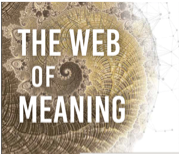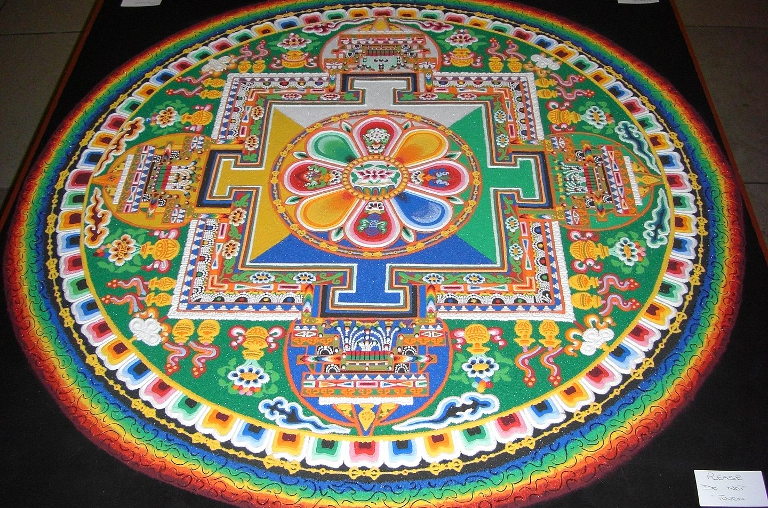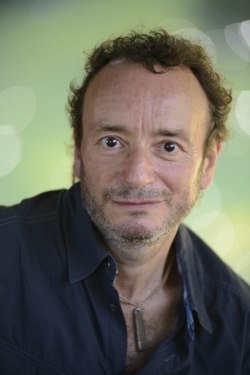 Ed. note: This excerpt from the Web of Meaning is published with the permission of the author.
Ed. note: This excerpt from the Web of Meaning is published with the permission of the author.
As our civilization careens toward a precipice of climate breakdown, ecological destruction, and gaping inequality, people are losing their existential moorings. Our dominant worldview has passed its expiration date: it’s based on a series of flawed assumptions that have been superseded by modern scientific findings.
The Web of Meaning: Integrating Science and Traditional Wisdom to Find Our Place in the Universe (published this week in the UK, next month in the US), offers a coherent and intellectually solid foundation for an alternative worldview based on deep interconnectedness, showing how modern scientific knowledge echoes the ancient wisdom of earlier cultures.
Here is the Introduction.
Tea with Uncle Bob
We could call it The Speech. You’ve probably heard it many times. Maybe you’ve even given it. Every day around the world, innumerable versions of it are delivered by Someone Who Seems to Know what they’re talking about.
It doesn’t seem like much. Just another part of life’s daily conversations. But every Speech, linked together, helps to lock our entire society up in a mental cage. It might occur anywhere in the world, from a construction site in Kansas to a market stall in Delhi. It can be given by anyone old enough to have learned a thing or two about how it all works. But it’s usually delivered by someone who feels they’ve been around the block a few times and they want to give you the benefit of their wisdom.
Because I grew up in London, I’ll zoom in there to a particular version of The Speech that reverberates with me. It’s an occasional family gathering—one of those events where toddlers take center stage and aunties serve second helpings of cake. It’s tea-time, and a few of us are gathered around, talking about the state of the world. Someone comments on what’s wrong with our system and how things could be so much better—but Uncle Bob happens to be in the group, and before you know it, it’s too late. The Speech is about to begin.
“Let’s face it,” Uncle Bob declares to the group, “it’s a dog-eat-dog world out there. Every man for himself. For all your ideas about making the world a better place, when it comes down to it, everyone’s just interested in their own skin. It’s a rat race. That’s the way all of nature works. That’s how we’ve been programmed. The survival of the fittest.”
Does any of this sound familiar to you? It’s only too familiar to those of us at the tea party. Uncle Bob sees some glazed faces looking back at him, so he feels the need to add a few more pointers to his oration.
“Look,” he leans forward conspiratorially, “it’s like this. People like you want to change the world. But when you’ve had the experience I’ve had, you’ll know better. Our society is structured this way simply because that’s what works best. They tried communism—and you know what happened to that. For all the complaining people do, they’ve never had it so good. Look at our amazing technology, look at all the progress we’ve made in the past few hundred years. You can thank capitalism for that. The fact is, it works so well, because at the end of the day people are selfish—they look out for themselves. Capitalism takes that selfishness and turns it into progress—it lets people become entrepreneurs, which makes all of us better off. That’s what they call . . . the invisible hand, isn’t it?”
Game over. Whatever ideas were being floated about improving society just wafted out the window. Uncle Bob pauses. The conversation comes to a halt, until someone pipes up: “How’s little Penny doing with her dancing lessons?”—and the tea party rolls on.
This type of conversation takes place with regularity around the world because it channels the themes we hear every day from those in a position of authority—from talking heads on TV, from successful businesspeople, from teachers, from school textbooks. Even when the Speech is not given explicitly, its ideas seep into our daily thoughts. Every time a newscaster reports on prospects for economic growth; every time a TV commercial hypes the latest consumer product; every time an exciting new technology is touted as the solution to climate change, the underlying themes of the Speech insidiously tighten their grip on our collective consciousness.
The flaws in our dominant worldview
Distilled to their essence, these themes come down to a few basic building blocks: Humans are selfish individuals. All creatures are selfish—in fact, selfish genes are the driving force of evolution. Nature is just a very complex machine, and human ingenuity has, for the most part, figured out how it works. The modern world is the spectacular result of technology enabled by the market forces of capitalism, and in spite of occasional setbacks, it’s continually improving. There may be problems, such as global poverty or climate change, but technology, powered by the market, will solve them—just as it always has in the past.
These basic elements, give or take a few, form the foundation of the predominant worldview. They infuse much of what is accepted as indisputably true in most conversations that take place about world affairs. They are so pervasive that most of us never question them. We feel they must be based on solid facts—why else would all those people in positions of authority rely on them? That’s the characteristic that makes a worldview so powerful. Like fish that don’t realize they’re swimming in water because it’s all they know, we tend to assume that our worldview simply describes the world the way it is—rather than recognizing it’s a constructed lens that shapes our thoughts and ideas into certain preconditioned patterns.
This book investigates the dominant worldview and shows that, in fact, every one of those building blocks is flawed. They were formed, in their modern version, mostly by a small group of men in seventeenth-century Europe, and further developed in the centuries that followed by other mostly European men. This worldview has accomplished a lot. It wrested intellectual control from the hidebound superstitions of traditional Christian theology, and laid the foundation for modern science—one of humanity’s greatest achievements. But it has also been an underlying cause of the horrendous devastation suffered by non-European peoples and cultures, and boundless destruction of the natural world. And the fundamental flaws in its construction have now become so gaping that they threaten the very survival of our civilization—and much of the living Earth.
Many people across the globe are realizing that there is something terribly wrong with the direction our world is headed. The inequities are so extreme that a couple of dozen billionaires own as much wealth as half the world’s population. Our civilization is devastating the Earth at an ever-increasing pace. There has been a 68 percent decline in animal populations since 1970. Greenhouse gas emissions have caused the climate to lurch out of control, creating conditions that haven’t existed on Earth for millions of years. Fires, storms, droughts, and floods that used to be called “once in a century” have become a regular staple of our daily news.
Look ahead a few decades, and things become downright terrifying. We’re on track, by the middle of this century, to see the annihilation of coral reefs worldwide, 95 percent of arable land degraded, and five billion people facing water shortages—and at the current rate, there will be more plastic in the oceans than fish. Without drastic changes, as we approach the later part of the century, the Amazon rainforest will have become a searing desert, the Sixth Great Extinction of species will be well under way, and as a result of climate breakdown, civilization as we know it will likely be tottering on its last legs.
A new foundation for our civilization
At our current trajectory, humanity is headed for catastrophe. But it doesn’t have to be that way. If we want to steer our civilization on another course, though, it’s not enough to make a few incremental improvements here and there. We need to take a long, hard look at the faulty ideas that have brought us to this place, and reimagine them. We need a new worldview—one that is based on sturdy foundations.
Imagine someone laying foundations for a single story house. If there are a few cracks, they will probably get away with it. But suppose generations of people keep adding new stories until they’ve built a skyscraper on the faulty foundation. As the building begins teetering, engineers might frantically attach extra girders and struts, but it will eventually collapse unless they pay attention to fixing the flaws in the foundation. That’s the situation our civilization faces right now.
This book lays out an entirely different foundation for a civilization that could lead us sustainably through this century and beyond. It reveals the flaws hidden within the current worldview, showing how certain erroneous ideas became so entrenched in popular thinking that they simply got taken for granted—and how that has led to our current predicament. Most importantly, it shows how the combined insights of traditional wisdom and modern scientific thinking offer a solid, integrated foundation for a different worldview—one that could redirect human civilization onto a very different trajectory, and offer future generations a flourishing world in which to thrive.
Why worldviews matter
The reason a worldview is so important is that it imbues virtually every aspect of the way people think, what they value, and how they act—without them even realizing it. Worldviews lead different cultures to respond to their reality in fundamentally different ways. If you believe that all living beings are family, you will treat them in a different way than if you think the natural world is a resource to be exploited. If you think other humans are inherently cooperative, you’ll approach a person differently than if you think that, ultimately, everyone is selfish and competitive. If you presume that technology can fix our biggest problems, you won’t feel the need to consider the underlying systems that caused those problems to arise in the first place.
In my earlier book, The Patterning Instinct, I looked at major worldviews through history, investigating how different cultures structured patterns of meaning into the universe from humanity’s earliest days in nomadic hunter-gatherer bands to modern times. One overarching theme emerged from The Patterning Instinct: a culture’s worldview shapes its values—and those values shape history. By the same token, the values according to which we conduct our lives today will shape the future. Ultimately, the direction of history is determined by the dominant culture’s worldview.
An integrated worldview
The Web of Meaning takes up where The Patterning Instinct left off, by laying out a framework for a worldview that could foster humanity’s long-term flourishing on a healthy planet. It is a worldview of integration: one that identifies the unifying principles that flow through all things, while celebrating the differences that lead to the richness of our lived experience. It’s a worldview that links together scientific findings in recent decades from such diverse fields as evolutionary biology, cognitive neuroscience, and complexity theory, showing how they affirm profound insights from the world’s great wisdom traditions, such as Buddhism, Taoism, and traditional knowledge from Indigenous peoples around the world.
This integrated worldview breaks down many of the barriers that tend to separate different forms of knowledge and activity in modern society. We’re accustomed to thinking of science as existing in a different domain than spirituality. We generally view the intellect as distinct from emotion; the mind as separate from the body; humans as separate from nature; and spiritual insight as separate from political engagement. In the integrated worldview laid out here, each one of these domains is intricately connected with the others in an extended web of meaning.
There are certain existential questions virtually every person asks at some time in their lives: Who am I? Where am I? What am I? How should I live?, and ultimately Why am I? The book is organized into sections according to these questions. For each one, we’ll investigate underlying flaws in the typical explanations provided by the dominant worldview, then explore the richly resonant answers offered by the intertwining of current scientific understanding with the deep insights of traditional wisdom. Finally, we’ll tackle the question many of us are anxiously asking right now: Where are we going?
Uncle Bob and me
These are all questions that I pondered during a period in my life when the structures of meaning I’d constructed for myself seemed to crash around me. For much of my own life, Uncle Bob’s statements had seemed irrefutably true. In fact, like many others, I built my life on their basis. I received my M.B.A at the University of Chicago where the precepts of free market capitalism were drummed into me. Finding myself in the San Francisco Bay Area at the onset of the dot com era, I founded the world’s first online credit card issuer, which I took public as its chief executive officer.
However, shortly after my company’s IPO, my wife developed early symptoms of the serious illness that would eventually lead to her untimely death. I left my executive role to care for her full-time—but the company was not yet firmly established, and within a couple of years it had become another casualty of the dot com bust. With my wife suffering cognitive decline from her illness, I found myself isolated—bereft of companionship, friends, and the prestige of success.
At that time, I made a solemn promise to myself that whatever path I chose for the rest of my life would be one that was truly meaningful. But where did meaning arise? Having traversed a road that seemed like a dead end, I was determined not to rely on someone else’s determination of what was meaningful. I thus began my own deep investigation into the sources of meaning, which launched a comprehensive research project lasting over ten years, resulting in both The Patterning Instinct and this book.
Something I learned on that journey, and which will become clear through the book, is that one’s personal search for meaning cannot be isolated from all that is going on in the world around us. In the pages that follow, as we trace the intimate connections that link our lives to those in our community, to all of humanity, and to the entire living Earth, we’ll discover how inextricably we are all interrelated—and explore some of the profound implications arising from that relatedness.
We’ll encounter many fascinating and unexpected revelations along the way. We’ll come across slime molds with the intelligence to solve mazes and design sophisticated road networks. We’ll discover how Chinese sages from a thousand years ago provided a framework that elucidates the radical findings of modern systems theorists. We’ll explore the stunning virtuosity of a single cell, and identify how the deep purpose of life reveals itself all around us—and within us. We’ll learn what ant colonies and flocks of starlings can teach us about our own consciousness. We’ll find out what Joni Mitchell got wrong in her environmental anthem “Big Yellow Taxi”—and what Michael Jackson got right when he sang “We Are the World.” We’ll see how our modern society has been consciously designed to sabotage our well-being, and how, by learning and applying life’s own principles, we can build an alternative civilization that could allow future generations to prosper on a flourishing Earth.
Explore The Web of Meaning further on Jeremy Lent’s website. The book is available for purchase now in the UK and preorder in the USA/Canada.
Teaser photo credit: Chenrezig sand mandala created at the House of Commons of the United Kingdom on the occasion of the Dalai Lama’s visit in May 2008. By The original uploader was Colonel Warden at English Wikipedia. – Transferred from en.wikipedia to Commons by SMasters using CommonsHelper., CC BY-SA 3.0, https://commons.wikimedia.org/w/index.php?curid=16371236






